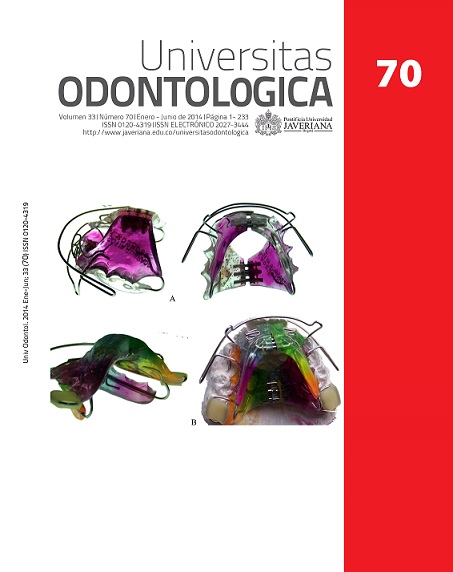Abstract
Purpose: To compare the state of bone maturation in a Colombian population with and without cleft lip palate (CLP), using cervical vertebral maturation (CVM) analysis. Methods: A previously calibrated examiner (kappa = 0.76) evaluated the CVM of 145 7-to-18-year-old individuals with and without CLP through lateral radiographs. 73 patients had CLP and 72 did not have the condition. Descriptive and inferential (chi2) statistical analyses were performed to the data (alpha = 0.05). Results: The 7-to-9-year-old group had the highest percentage of cervical vertebras in stage CS1 and none in stages CS5 and CS6. Patients in the group of 10-12 years of age showed the highest frequency in stage CS4 and none in CS6. The 13-15 year olds had the highest proportion in CS4. Among the 16-to-18-year-old patients, the highest percentage was found in stage CS5. When comparing the cervical vertebral development between the two groups, there were no significant differences (p = 0.8). Conclusion: The state of bone maturation in individuals with and without CLP showed similar results when analyzed regarding CVM in lateral radiographies. There was no evidence of earlier maturation in the 7-to-9-year-old patients. The highest level of growth was shown at ages 10-15 (CS3, CS4).
KEYWORDS
cleft lip and palate; cervical vertebral maturation; growth and development
Tiziano Baccetti, Lorenzo Franchi, James McNamara. The Cervical Vertebral Maduration (CVM ) Method for the Assessment of Optimal Treatment Timing in Dentofacial Orthopedics. Angle Orthod. 2002; 72(4): 316-23.
Tanner JM. Foetus into Man. London: Open Books Publ. LTD, 1978
Rajion ZA, Townsend GC, Netherway Dj, Anderson PJ, Yusof A, Hughes T, Shuaib IL, David Dj. Three-dimensional Computed Tomographic Analysis of the Cervical Spine in Unoperated Infants with Cleft Lip and Palate. Cleft palate craneofac J. 2006 ; 43(5): 513-8.
Franchi L, Baccetti T, McNamara JA Jr: Treatment and Posttreatment Effects of Acrylic Splint Herbst Appliance Therapy. Am J Orthod Dentofacial.Orthop 1999. 115:429-438.
Baccetti T, McGill JS, Franchi L, et al: Skeletal Effects of Early Treatment of Class III Malocclusion with Maxillary Expansion and Face-mask Therapy. Am J Orthod Dentofacial Orthop 1998.113:333-343.
Lamparsky DG. Skeletal age Assessment Utilizing Cervical Vertebrae. J Anat. 1975; 11(1): 49-68.
Maria T O´Reilly, Gary J Yanniello, Mandibular Growth Changes and Maturation of Cervical Vertebrae – A Longitudinal Cephalometric study. The Angle Orthodontist, 1988,58(2):179-84.
Sun L, Li WR, Cervical vertebral maturation of female children with orofacial clefts, Cleft Palate Craniofac J. 2013 Sep;50(5):535-41.
Sun L, Li WR. Cervical vertebral maturation of children with orofacial clefts. Cleft Palate Craniofac J. 2012 Nov;49(6):683-8.
Ceglia A. Indicadores de Maduración de la Edad ,Ósea, Dental y Morfológica. Revista Latinoamericana de Ortodoncia y Odontopediatria [Internet] 2005 mayo. Disponible en: http:// www.ortodoncia.ws
Bench R. Browth of the Vervical Vertebrae as Related Tongee, Face and the Venture Behaviore. Am J orthod. 1963; 3:183-214
Perinetti G, Contardo L, Gabrieli P, Baccetti T, Di Lenarda R. Diagnostic performance of dental maturity for identification of skeletal maturation phase. Eur J Orthod. 2012 ;34(4):487-92.
Baptista RS, Quaglio CL, Mourad LM, Hummel AD, Caetano CA, Ortolani CL, Pisa IT. A semi-automated method for bone age assessment using cervical vertebral maturation. Angle Orthod. 2012;82(4):658-62.
Rudman D, Davis T, Priest JH, Patterson JH, Kutner MH, Heymsfield SB, Bethel RA. Prevalence of growth hormone deficiency in children with cleft lip or palate. J Pediatr. 1978; 93:378–382.
Bowers EJ, Mayro RF, Whitaker LA, Pasquariello OS, LaRossa D, Randall P. General body growth in children with clefts of the lip, palate and craniofacial structure. Scand J Plast Reconst Surg.1987;21:7–14.
Zarate YA, Martin LJ, Hopkin RJ, Bender PL, Zhang X, Saal HM. Evaluation on growth in patients with isolated cleft lip and palate. Pediatrics. 2010; 125 (3) : 543-9.
Rózylo-Kalinowska I, Kolasa-Raczka A, Kalinowski P. Relationship Between Dental Age According to Demirjian and Cervical Vertebrae Maturity in Polish Children. Department of Dental and Maxillofacial Radiology. Eur J Orthod. 2011;33(1):75-83.
Balachandran G. Klippel-Feil Syndrome and Anterior Cervical Meningomyelocele: a Rare Case Report.AJNR Am J Neuroradiol. 2009;30(9): 130.
Kaban LB, Seldin EB, Kikinis R, Yeshwant K, Padwa BL, Troulis MJ. Clinical Application of Curvilinear Distraction Osteogenesis for Correction of Mandibular Deformities. J Oral Maxillofac Surg. 2009 ;67(5):996-1008.
Thompson DN, Slaney SF, Hall CM, Shaw D, Jones BM, Hayward RD. Congenital cervical spinal fusion: a study in Apert syndrome. Pediatr Neurosurg. 1996;25(1):20-7.
This journal is registered under a Creative Commons Attribution 4.0 International Public License. Thus, this work may be reproduced, distributed, and publicly shared in digital format, as long as the names of the authors and Pontificia Universidad Javeriana are acknowledged. Others are allowed to quote, adapt, transform, auto-archive, republish, and create based on this material, for any purpose (even commercial ones), provided the authorship is duly acknowledged, a link to the original work is provided, and it is specified if changes have been made. Pontificia Universidad Javeriana does not hold the rights of published works and the authors are solely responsible for the contents of their works; they keep the moral, intellectual, privacy, and publicity rights.
Approving the intervention of the work (review, copy-editing, translation, layout) and the following outreach, are granted through an use license and not through an assignment of rights. This means the journal and Pontificia Universidad Javeriana cannot be held responsible for any ethical malpractice by the authors. As a consequence of the protection granted by the use license, the journal is not required to publish recantations or modify information already published, unless the errata stems from the editorial management process. Publishing contents in this journal does not generate royalties for contributors.


